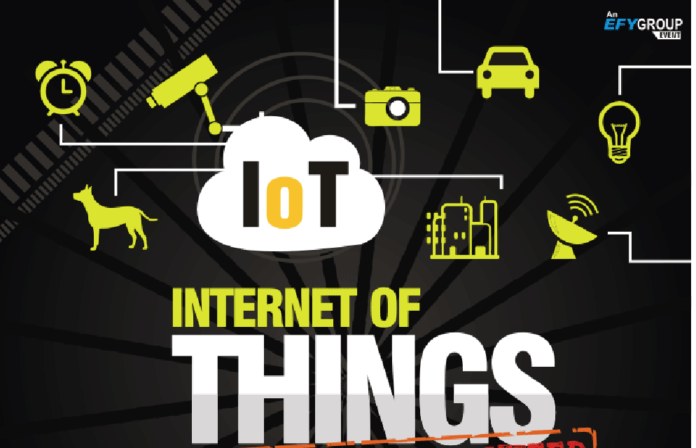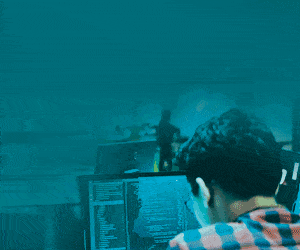Internet of Things Enthusiasts in Bangalore (IoTBlr) is a thriving DIY community in Bangalore, populated by techies working to create stuff for the Internet of Things (IoT). Apart from being a wonderful resource for IoT learning and experimentation, the group is also a great example of the growing DIY phenomenon. Janani Gopalakrishnan Vikram caught up with Nihal Kashinath, founder of the group, Nagasai, co-organiser, and Sayan Chakraborty, a key member of the group who is working to create a permanent hackerspace for it, to find out more about the work they do and the relevance of DIY to the IoT.
About the group…
What kind of projects do you work on?
Nihal: Our projects are in the realm of electronics and Internet-based communication – hardware + software. Most of our current
projects were proposed by group members at a recent brainstorming session. Individuals signed up for the particular project(s) they were interested in, and they later organised themselves into teams. Many are still in the early stages since we have only recently started, but some projects were pre-existing and people are using this group to find experts and/or partners to advance those projects.
How many people are there in your group?
Nihal: We are a very young group, about two months old, but the group has grown really fast. We currently have 160 members in our meetup.com group and about 140 in our Facebook group. Note that there is an overlap between the two with a lot of members joining both groups, so the number of individuals in the IoTBLR group is not 300!
Do you work only online or also meetup?
Nihal: So far we have been meeting in person once every two weeks (typically every other Sunday afternoon) at Bangalore Alpha Labs in Koramangala. These meets are open to the entire community. Apart from this, project teams meet as required to work together on their projects. A lot of discussions also happen online, mostly on the Facebook group where we share interesting projects or developments in the IoT space from around the world, or to coordinate our next meeting.
The truth is, while online services like FB, Google docs, hangout, etc. provide a lot of useful tools for coordinating and collaborating, working together in person is critical for us since the projects we do are invariably hardware-related. We are currently looking for a place where we can do that, and even house all our equipment and components in a more permanent setup – a hackerspace of sorts. Sayan is leading that effort.
Internet of Things DIY
In the context of the IoT, considering its ubiquity, is DIY a must? What is your opinion on this?
Sayan: You are right in indicating that almost all of us are current or potential consumers of IoT devices and services. My take on this is that IoT presents a unique opportunity to the DIY community. What is different is that it is an entirely Greenfield area of innovation where large organisations and individuals or DIY groups have similar levels of maturity. Platforms like the Arduino, MSP430 Launchpad and Raspberry Pi have democratised innovation and reduced the barrier to entry significantly so that even a high school student with interest can get started on making interesting projects or devices.
Let us not forget many of the great companies around started as projects nurtured by the DIY community. One oft-quoted example is the birth of Apple and their close association with the Homebrew Computer Club.
IoT being a large goal of connecting all objects from toasters to door bells, it definitely needs the contribution of many – so how do you perceive your group as making a difference in this?
Nihal: In the short term, creating awareness and building enthusiasm about IoT amongst professionals will help drive the movement. As more people get involved, they learn from each other, come up with several great ideas, implement them and extend the IoT network. In the long term, introducing kids to building things will get them excited about IoT and help make it sustainable. Along with all this, bringing in companies and commercialising technology will ensure that the economics work out, which is critical to the success of any large-scale movement. Our group is basically building the ecosystem to make all this happen.
Naga: The challenge with IoT is scalability, resource optimisation and adhering to new upcoming standards. Two key factors in realising this are affordability of knowledge + resources and culture. So, the people should be up-to-date with new standards and discuss various architectures required for scalable solutions. In our group, we are putting in efforts to share knowledge amongst the community, bringing like-minded people together to work on projects, crowd-sourcing the hardware boards etc. Most of the knowledge is new to India and the ideas/problems/solutions are influenced by the West. Once knowledge starts flowing through the community, then we expect an Innovation Blowback Effect. Not only solving problems in India but also of the rest of the developing + developed world. The key dimension to IoT product success would be design. Right now we could attract technology enthusiasts and we are looking forward to bringing them closer to designers.
Components and resources
There are several boards available today for DIY projects – Arduino, Pi, etc. – but I guess the components you require for IoT projects might have different requirements in terms of form factor, power consumption, etc.? Can you provide some information on the kind of components you use?
Nihal: Among the group, members own several types of boards – Arduino, Raspberry Pi, Beagleboard, Stellaris, MSP430, etc. We basically use whatever serves our purpose for a particular project. However, choosing the right board (and hardware in general) is a recurring challenge for us and we are trying to develop a knowledge base around it. Not sure how easy it would be to keep it updated and accurate, given the rate at which new and improved board variants are coming out.
Naga: Yes the components required vary a lot among IoT projects, especially to tackle constraints of processing power, memory, power consumption etc. For initial prototyping, we are working on crowd-sourcing of the resources and boards like Arduino, Raspberry Pi, Beagleboard, Telos B etc. For commercialised versions, we need to design our own cost-effective hardware solution. Moore’s law will play a significant role in IoT but not as it was portrayed to improve processing power. In the IoT case, it would be mostly used to improve power consumption and reducing cost of the hardware. So to create an IoT product, we need to have custom hardware according to the requirements and design. And we need to create a knowledge base around that.
There are many platforms today that claim to ease connectivity for IoT products – Contiki-based Thingsquare, Xively, etc. Do you think these are worth the bucks, or do you go with plain vanilla operating systems for your projects?
Nihal: I personally advocate building on others’ work in this space, since they’ve already solved certain problems and you don’t have to waste time and resources (funds, expertise, energy) solving the same problems again. Makes a huge difference when working with limited resources and when time-to-market is critical. For open source, that already happens fairly efficiently. With proprietary/closed systems, there is an inherent loss of control over the project parameters. If that doesn’t affect your design too much, go for it. Of course, it also depends on the resources you are willing to spend on this.
Naga: Most of the platforms are of open source licenses. One needs to be aware of which license they are using, and adhere to the open standards by IETF, IEEE. For example, Contiki-based platforms are BSD-style license, which allows commercialisation of the product. As we look at history and the success of open platforms, we think using open platforms that comply with standards are the right way to go.
What do you consider the best online resources – learning and component purchasing – for DIY enthusiasts in India?
Nihal: SimpleLabs and ExploreLabs are good places to buy equipment in India. They have a decent collection, you can place the order online and they will ship the components carefully. They can even put together Starter Kits for those who do not really know what components they need to get started.
In terms of learning, obviously the best entry point is a Google search, and there are several tutorials, videos and communities dedicated to IoT on the Web. There are also some good books on the subject and some course material from universities teaching IoT. For India, since many of our challenges are unique to us, the global forums may not have the answers we seek. So one of the best resources you can get is a local group of enthusiasts who can work and learn together. Most cities should already have local groups. If you are in Bangalore, come join IoTBLR. If there is no such group in your city, why not start one?
Naga: Component purchasing is still a struggle in India. The pricing of online hardware stores is higher than the physical stores. But finding components on the foot is also challenging. As for learning, there are plenty of online resources for IoT. Anyone with knowledge of computer networking protocols can learn IoT protocols with ease. The next advanced level would be reading IETF Request-for-Comment (RFC) pages on 6LoWPAN, CoAP etc. The recent popularity of open source hardware has made it easy to get online information on using various boards and hardware designing.
On the importance of meet-ups
How important is it for DIY enthusiasts to connect with others of the community – and does online collaboration have to be supplemented with physical gatherings too?
Connecting with a community is extremely important. DIY and IoT are multidisciplinary streams, so it’s very difficult (although not impossible) for one person to manage all aspects of design, software, hardware, etc. of a project. Being part of a group allows you to find like-minded individuals with whom you can collaborate and build things bigger, better and faster.
Since DIY essentially involves physical objects, it is very important to have physical gatherings where you can work with others, using screwdrivers and soldering irons. Besides, it’s more fun! But it is not practical to meet all the time, so that’s where online collaboration plays a huge role.
Naga: It is highly important. DIY is a collaborative art-work and in order to create an art together, we need to meet at regular intervals of time. And DIY is not just technology; user-centric designers and product designers play a significant role. In Indian colleges, we don’t have (or extremely few) interdisciplinary collaborative coursework that involves both technologists and designers. So we need to bring them together in physical gatherings
When you guys meet, what are the key concepts/ problems discussed? Can you give a few examples?
Sayan: Our meetings are very informal and in the spirit of the makerspace/ hackerspace culture we actively encourage collaborative learning. Interesting project ideas and implementations are discussed openly and voted on. Teams are formed based on the interest of the members. Some of the key concepts we are dealing with these days is the evolving 802.15.4 wireless standards. We have had a session on the pros and cons of open standards (like 802.15.4) vs. proprietary wireless standards.
We have also had a very fruitful session discussing hardware platforms, from the well-known ones like the Arduino, MSP430 and Raspberry to the relatively less known but extremely energy efficient ones like the EFM32. Each platform was thoroughly discussed and their individual advantages or disadvantages especially from an Indian context were documented. This helps the various project teams decide on a set of common platforms and tools to decrease the development effort. We all come from different fields and these sessions enable us to learn new things and share ideas.
Of the project ideas that have come up in your group, can you describe one that you find most interesting?
There are number of interesting projects and we encourage people to form their own teams based on their interest or capabilities. There are some themes currently popular with the group including automation for home, retail, medical, agriculture and location tracking. My current favourite is a pollution monitoring and reporting system that uses GPS location tracking and mesh networking between the nodes.














